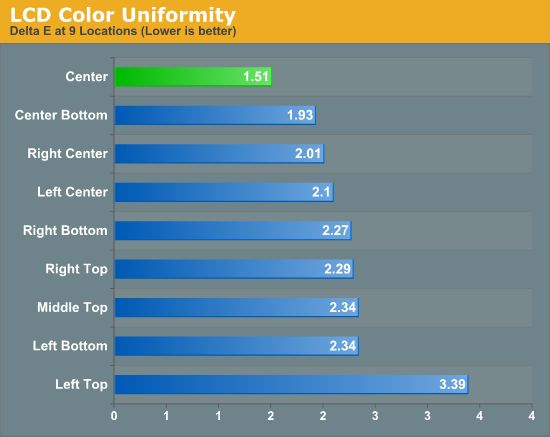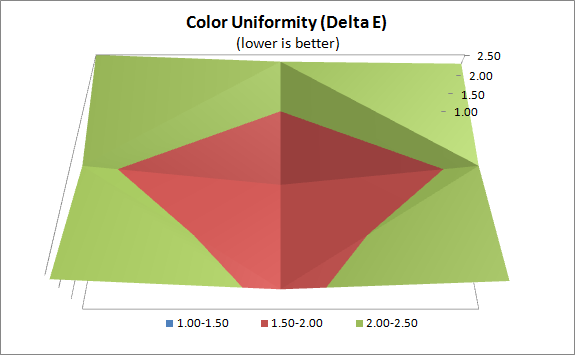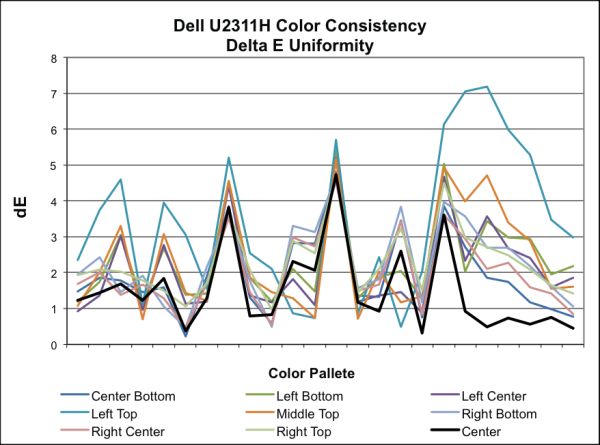Dell U2311H: E-IPS, Full Adjustments, and DisplayPort
by Chris Heinonen on September 27, 2011 12:20 AM ESTColor Gamut


The Dell measured just below 70% of the Adobe RGB gamut, about where we would expect for a panel with a normal CCFL backlight. For most users working in an sRGB color space, 70% can actually be better than 100%, as higher color gamuts can produce oversaturated colors in non-color-aware applications.
One thing that is different about the panel in the Dell is that it’s a newer E-IPS panel that only has 6-bits of color depth instead of 8-bits, which would typically only provide access to 65,536 colors and not the usual 16.7 million. What this means is that to effectively display all of those colors and shades, the pixels will have to quickly shift intensity levels instead of being able to remain solid at one level. For colors that don’t need to use this method of dithering, such as white, they will look rock solid, but if you look at a black to white gradient, you can notice shades of gray where this dithering is happening. Used at a reasonable distance, you might not notice this at all, but close up you will probably be able to see it. I wasn’t particularly bothered by this behavior, but some people might be.
Color Uniformity
All monitors typically calibrate using a single point in the center of the display, but of course you don’t do all of your work there. Color and brightness uniformity can vary across the panel by a large margin as the LCD backlights are typically positioned at the edges of the screen, except for rare cases, which doesn’t allow for a perfectly even distribution of light. Here we see how the Dell does by taking our 200 nits profile and once again running our color checked at nine different locations on the screen.


The Dell has a low average dE of 1.51 in the center for the display and that creeps up as we move towards the edges, with a peak dE of 3.39 in the upper left corner of the unit. Overall the majority of the error is below 3 and would not be visible to the naked eye, but above what we would prefer it would be for print work. Just like with the initial reading, you can see it is those colors that are made up mostly of blue light that are causing the issue and so the numbers might be a little deceptive in how bad the problem is.











65 Comments
View All Comments
Flunk - Sunday, October 2, 2011 - link
I have one of these, bought it for $220 CDN on sale a month or so ago. I haven't had any problems playing FPSes on it but your mileage may vary.I've been impressed by the build quality and the picture is better than any other monitor I've ever had, if you're not a graphics professional (then you need a 8bit panel) it's definitely a step above.
JoeTF - Tuesday, September 27, 2011 - link
Uhm.Input lag is THE MOST IMPORTANT measurement with e-IPS displays, that are notorious for 30ms+ delays.
Skipping it is like skipping sequential read tests in hdd review.
gevorg - Tuesday, September 27, 2011 - link
This is a previous gen monitor, plenty of reviews on the web. Input lag was measured here:http://www.tftcentral.co.uk/reviews/dell_u2311h.ht...
enterco - Tuesday, September 27, 2011 - link
I own a Dell U2311H, I can't see any noticeable lag. Anyway, the pixperan tool (pixel persistence analyzer) test image looks much better on this display than on my old TN display.ckryan - Tuesday, September 27, 2011 - link
Chris,Are you the new display intern? I too inquired about the highly coveted display internship, but sadly had been beaten to the punch. Ironically, I too am named Chris, and since I had just purchased a new U2311H from Dell, was planning on doing a "review application" of it.
It's a good monitor for the price, but mine has some less than desirable characteristics. However, the input lag is quite low as verified by a couple of other reviews (and my eyeballs), and I only find the off-angle darkening slightly annoying. It calibrates pretty well for me and has excellent black levels for an IPS variant -- that, plus I find CCFL to be generally superior. Just because a display is LED backlit doesn't automatically mean it uses less power -- it's often the case, but identical models that vary solely by backlight use similar amounts of power. Finally, I haven't noticed any artifacts from the 6 bit + AFC implementation, which is a bonus. Overall it's pretty good, but now it's kinda close to the U2412 in price now that it's out, and it looks like a better way to go if you're a fan of 16:10 (and who isn't?).
Anyway, congrats and I'm looking forward to your future reviews.
Daniel Egger - Tuesday, September 27, 2011 - link
> that, plus I find CCFL to be generally superior.CCFL die! Not dead yet? Damn...
The only problem with LED is that companies can't get their stuff together and do it properly and thus we still see crappy LED backlit displays while the high end still tends to use the more known CCFL backlight.
But since NEC recently announced a (what will hopefully turn out to be a nice) LED projector I'm getting my hopes up that we will eventually see a high end LED display from NEC as well. Once that happens HP and Dell will follow suit and we'll have an avalanche of professional grade LED backlit displays coming for us...
Pessimism - Tuesday, September 27, 2011 - link
CCFL needs to die. They may look nicer out of the box but give them a year and they all look weak and yellow. The manufacturers use the cheapest tubes they can find with poor quality phosphors that rapidly loose brightness and color balance. At least LEDs remain consistent for longer, with those you deal with the clear plastic lenses yellowing, again because of poor quality materials.jecs - Tuesday, September 27, 2011 - link
Don't hope CCFL to die too soon or we may get a lot of color precision problems. CCFL may seem old tech but it still produces more neutral color across the spectrum than a white only LED lamp. The downside is more power consumption and heavier units but it is not as important for professionals as it may be for consumers.On the other hand high end LED screens found today on very expensive TVs or monitors uses 3 LED color matrices for each color (RGB). So don't expect anything true LED for desktop use anytime soon.
softdrinkviking - Tuesday, October 4, 2011 - link
jecs +1LEDs still have a long way to go.
they look washed out without being as bright as a CRT. (to me)
alanwong - Tuesday, September 27, 2011 - link
They're selling the U2312HM here in Australia, assume that means the U2311H is out of date?